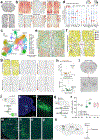A master regulator of opioid reward in the ventral prefrontal cortex
- PMID: 38843332
- PMCID: PMC11323237
- DOI: 10.1126/science.adn0886
A master regulator of opioid reward in the ventral prefrontal cortex
Abstract
In addition to their intrinsic rewarding properties, opioids can also evoke aversive reactions that protect against misuse. Cellular mechanisms that govern the interplay between opioid reward and aversion are poorly understood. We used whole-brain activity mapping in mice to show that neurons in the dorsal peduncular nucleus (DPn) are highly responsive to the opioid oxycodone. Connectomic profiling revealed that DPn neurons innervate the parabrachial nucleus (PBn). Spatial and single-nuclei transcriptomics resolved a population of PBn-projecting pyramidal neurons in the DPn that express μ-opioid receptors (μORs). Disrupting μOR signaling in the DPn switched oxycodone from rewarding to aversive and exacerbated the severity of opioid withdrawal. These findings identify the DPn as a key substrate for the abuse liability of opioids.
Figures





References
-
- Shippenberg TS, Bals-Kubik R, Herz A, Examination of the neurochemical substrates mediating the motivational effects of opioids: role of the mesolimbic dopamine system and D-1 vs. D-2 dopamine receptors. J Pharmacol Exp Ther 265, 53–59 (1993). - PubMed
-
- Spyraki C, Fibiger HC, Phillips AG, Attenuation of heroin reward in rats by disruption of the mesolimbic dopamine system. Psychopharmacology (Berl) 79, 278–283 (1983). - PubMed
Publication types
MeSH terms
Substances
Grants and funding
LinkOut - more resources
Full Text Sources
Medical
Molecular Biology Databases
Research Materials

